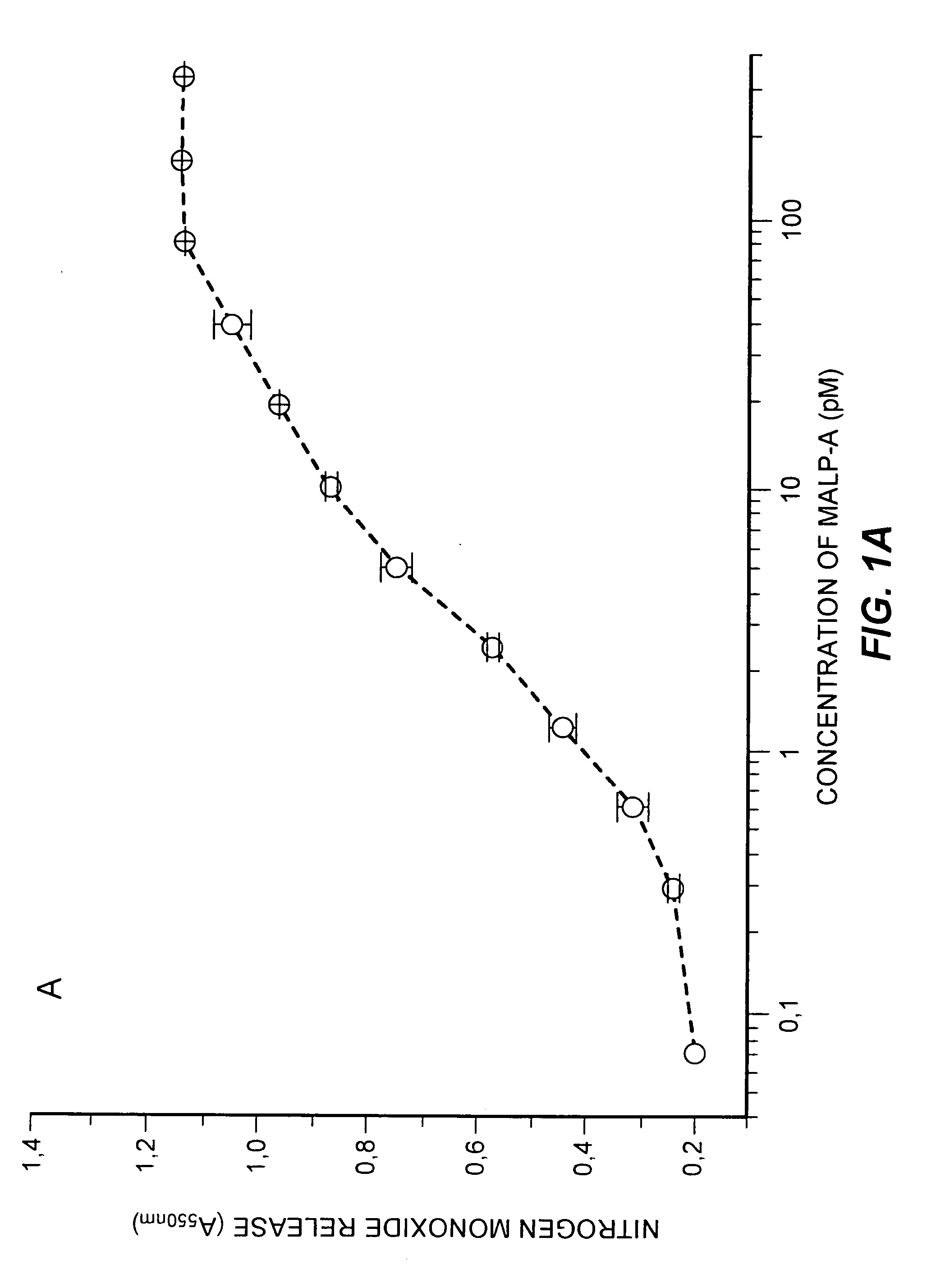Utilization of lipopeptides or lipoproteins in wound treatment and infection prophylaxis
a technology of lipoproteins and wound treatment, applied in the field of wound treatment and infection prevention, can solve the problems of high delay or inability of wound healing, inability to control during application, and delay in wound healing
- Summary
- Abstract
- Description
- Claims
- Application Information
AI Technical Summary
Benefits of technology
Problems solved by technology
Method used
Image
Examples
example 1
[0048] Macrophage Activation by Synthetic Lipopeptides Derived from Mycoplasmas, Measured with the Nitrogen Monoxide Liberation Assay
[0049] An easily quantifiable assay for the activation of murine macrophages with lipopeptides is the liberation of nitrogen monoxide from peritoneal exudate cells in the presence of interferon-γ; see, for example, Mühlradt & Frisch, Infect. Immun., 62:3801-3807 (1994). This assay is carried out with peritoneal exudate cells of C3H / HeJ mice, which react only slightly with endotoxin, using microtiter plates (96 wells). Simultaneously, 105 cells are stimulated with recombinant IFN-γ and a serial dilution of a material which activates macrophages. After incubation for 48 hours, the nitrate is reduced with nitrate reductase; NO is determined as the sum of nitrite and nitrate with the Griess reagent.
[0050] The macrophage-stimulation activity of the following lipopeptides is compared in FIGS. 1A to 1D.
[0051]FIG. 1A: MALP-A: S-[2,3-Bispalmitoyloxy-(2RS)-pr...
example 2
[0056] The model of inflow of granulocytes and macrophages into the peritoneal cavity of the mouse served as an example of the effectiveness of synthetic lipopeptides or liposomes into which such lipopeptides were incorporated. NMRI-outbred mice were used as experimental animals in order to exclude genetic peculiarities.
[0057] The racemic lipopeptide MALP-2 was synthesized according to Mühlradt et al., J. Exp. Med., 185:1951-1958 (1997)], the compounds R-MALP-2=S-[2,3-Bispalmitoyloxy-(2R)-propyl]cysteinyl-GNNDESNISFKEK (SEQ ID NO:10) or S-MALP-2=S-[2,3-Bispalmitoyloxy-(2S)-propyl]cysteinyl-GNNDESNISFKEK (SEQ ID NO:8) were synthesized according to reference [Metzger et al., J. Medicinal Chem., 34:1969-1974 (1991)]. MALP-containing liposomes were constructed as follows: The lipids dissolved in chloroform or chloroform / methanol (1+1) (phosphatidyl glycerol, phosphatidyl serine, cholesterol, NBD-PE, molar ratio 1.08:1:0.25:0.005) were pipetted together with the MALP-2 dissolved in 2-pr...
example 3
[0068] The importance of the asymmetric C-atom at C2 of the dihydroxypropyl group for the in vivo effect is shown in Table 2. Here, as above, groups of 5 NMRI mice were treated with different amounts of R-MALP-2=S-[2,3-Bispalmitoyloxy-(2R)-propyl]cysteinyl-GNNDESNISFKEK (SEQ ID NO:10) or S-MALP-2=S-[2,3-Bispalmitoyloxy-(2S)-propyl]cysteinyl-GNNDESNISFKEK (SEQ ID NO:8)applied intraperitoneally, and after 3 days the total number as well as the composition of the peritoneal leukocytes were determined. S-MALP-2 is clearly more effective.
PUM
| Property | Measurement | Unit |
|---|---|---|
| molar ratio | aaaaa | aaaaa |
| pH | aaaaa | aaaaa |
| volumes | aaaaa | aaaaa |
Abstract
Description
Claims
Application Information
 Login to View More
Login to View More - R&D
- Intellectual Property
- Life Sciences
- Materials
- Tech Scout
- Unparalleled Data Quality
- Higher Quality Content
- 60% Fewer Hallucinations
Browse by: Latest US Patents, China's latest patents, Technical Efficacy Thesaurus, Application Domain, Technology Topic, Popular Technical Reports.
© 2025 PatSnap. All rights reserved.Legal|Privacy policy|Modern Slavery Act Transparency Statement|Sitemap|About US| Contact US: help@patsnap.com



